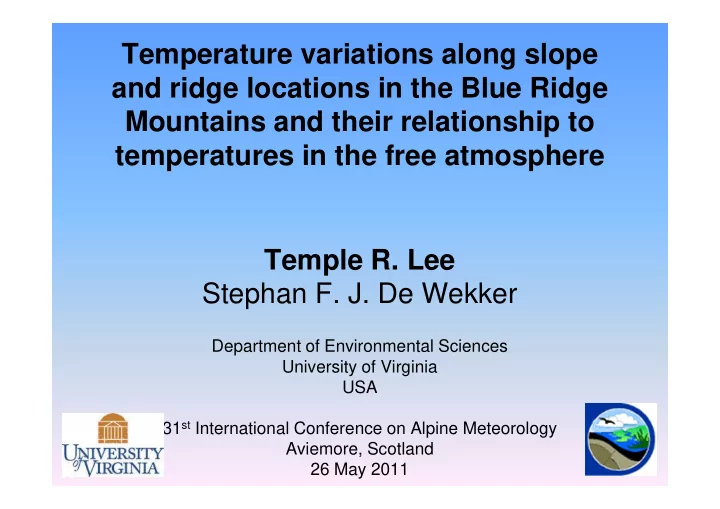

Temperature variations along slope and ridge locations in the Blue Ridge Mountains and their relationship to temperatures in the free atmosphere Temple R. Lee Stephan F. J. De Wekker Department of Environmental Sciences University of Virginia USA 31 st International Conference on Alpine Meteorology Aviemore, Scotland 26 May 2011
DX =100-500 km GCM Downscaling NARCCAP Topography (50 km) Dynamical Statistical DX =30 - 100 km Drive RCM with GCM Evaluate spatial and boundary conditions temporal relationships between model and observations PRISM Topography (0.8 km) Further Downscaling DX =1 km Parameter-elevation Relationships on Independent Slopes Model (PRISM), a statistical algorithm that combines monthly and annual- mean data from all available stations 2
Importance • Important to: – Climate change projections in hydrological and ecological models – Weather forecasting in complex terrain • However, before climate models can be downscaled, we need to better understand local impacts on temperature, i.e. local topography and vegetation 3
Impacts of Topography • Local slope characteristics (e.g. Whiteman, 2000) • Azimuth • Elevation • Inclination • Mass elevation effect (Schroter, 1908) • Smaller diurnal temperature range at sites with more exposure to the free atmosphere Impacts of Vegetation • Daytime temperatures warmer over grasslands than forests on summer afternoons (e.g. Morecroft et al., 1998) • Larger diurnal temperature range over grasslands • Discrepancy in nighttime temperature differences between forests and grasslands • Forests cooler at night • Accumulation of cold air near surface due to absence of turbulence (e.g. Laughlin, 1982; Karlsson, 1999) • Forests warmer at night • Obstruction of outgoing longwave radiation from surface (e.g. Geiger et al., 1995) • Studies conducted in flat terrain, valley sites; no known studies at mountaintops 4
Research Questions • How does the diurnal temperature range compare between a forested and non-forested site with different nearby topographic characteristics? • How do the observed temperatures at a forested and non-forested site compare with the surrounding free atmosphere? 5
6
Pinnacles • Measurements (half-hour average) • Temperature (2, 5, 10, 17 m) • Humidity (2, 5, 10, 17 m) • Wind speed and direction (10, 17 m) • Net radiation (17 m) • Precipitation (2 m) • Pressure (14 m) • CO, CO 2 mixing ratios* (5, 10, 17 m) • O 3 mixing ratio (17 m) • Aerosol backscatter • Period of Record • 1 July 2008 – present 1017 m msl Mean surface albedo: 0.21 *See Lee, T. R. and S. F. J. De Wekker, 2011: Carbon dioxide variability and frontal passages at a forested mountaintop in the Blue Ridge 7 Mountains. 31 st International Conference on Alpine Meteorology.
Big Meadows • Measurements (hour average) – Temperature (2 m) – Humidity (2 m) – Wind speed and direction (10 m) – Rainfall (2 m) – Incoming solar radiation (10 m) – Ozone (10 m) • Period of Record – Daily Records: 1 January 1935 – present – Hourly Records: 1 July 1988 – present 1079 m msl Mean surface albedo: ~0.20 8
Nearby topography (1 km 2 ) Pinnacles Big Meadows Contour Interval: 3 m Pinnacles Big Meadows 15 m DEM data 9
Hypotheses • A smaller diurnal temperature range is expected at Pinnacles than Big Meadows because of – Presence of nearby canopy cover – More exposure to the free atmosphere • Temperatures at Pinnacles are expected to more closely resemble free atmosphere temperatures than temperatures at Big Meadows (mass elevation effect) 10 Pinnacles Big Meadows
Methods • Data from 1 January 2009 – 31 December 2010 • Free atmospheric temperatures from Sterling NWS (98 km northeast of Big Meadows) • Hourly averages of half-hour data obtained for Pinnacles data to facilitate the comparison between two sites Mean Daily Temperature 11
Test for Radiation Errors • Following Nakamura and Mahrt (2005): Daytime Nighttime 14 April 2011 Red: Non-aspirated, 2 m Blue: Correction Factor Used Black: Aspirated, 2 m 12
Daily Temperature Range Average over 1 Jan 2009—31 Dec 2010 (N=596) Black: Big Meadows, 2 m Red: 2 m Blue: 5 m Green: 10 m Orange: 17m Daily Temperature Range ( o C) Pinnacles 2 m 4.7 5 m 4.3 10 m 4.0 17 m 3.3 2 m 4.2 Big Meadows 13
Relationship with free atmosphere temperatures RMSE Dashed line: Big Meadows: 1.57 1:1 Line Pinnacles (2 m): 1.66 Pinnacles (17 m): 1.57 2 m temperatures at Big Meadows are more similar to free atmosphere temperatures than 2 m temperatures at Pinnacles 14
Could wind speed differences explain observed temperature differences between Pinnacles and Big Meadows? Orange: Pinnacles, 17 m Blue: Pinnacles, 10 m Black: Big Meadows, 10 m Stronger daytime winds at Big Meadows (10 m agl) more convective mixing and exchange with overlying (cooler and windier) free atmosphere surface temperatures at Big Meadows cooler and closer to free atmosphere temperatures than Pinnacles 15
Conclusions • Largest diurnal temperature differences 2 m agl at Pinnacles. However, both minimum and maximum temperatures are larger at Pinnacles than at Big Meadows. • The diurnal variation of wind speed is different at Pinnacles and Big Meadows, suggesting differences in boundary layer and free atmosphere mixing due to differences in exposure of the two sites. • Higher daytime wind speeds 10 m agl at Big Meadows than Pinnacles may explain lower temperatures at Big Meadows. Future Work • Relate results to network of temperature measurements near Pinnacles and along nearby mountain slopes • Investigation of boundary layer structure along the mountain ridge • Modeling using the Weather Research and Forecast (WRF) model to better understand the role of mass elevation effects and boundary layer mixing on temperature differences along the mountain ridge 16
Recommend
More recommend